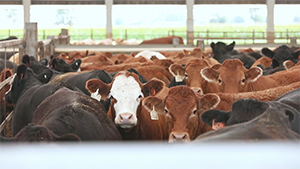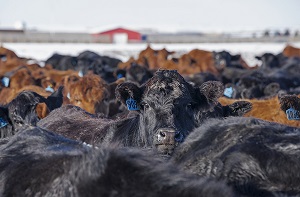Always Look a Gift Cow in the Mouth

This article written by Dr. Reynold Bergen, BCRC Science Director, originally appeared in the November 2021 issue of Canadian Cattlemen magazine and is reprinted on the BCRC Blog with permission of the publisher.
This year’s feed situation is forcing many cow-calf producers to make very difficult decisions. Those who are short of feed may cull their herds harder than usual or look for alternative feeding arrangements to winter some or all their cows. Others with feed carryover from previous years may be tempted to custom feed other people’s cows, or to expand their own herds. Those who are selling cows this year may rebuild their herds in a year or two when the weather is more promising. In short, there are potentially a lot of cows changing hands, either permanently or temporarily.
Regardless of whether you’re buying now, buying later or considering custom feeding, remember that there’s more to the decision than price alone. Some apparent opportunities can bring significant hidden costs. This lesson was illustrated recently in a project led by John Campbell and Cheryl Waldner, with co-workers from the Universities of Saskatchewan and Calgary (Biosecurity Practices in Western Canadian Cow-Calf Herds and Their Association with Animal Health; Canadian Veterinary Journal 62:712-718).
What they did:
These researchers surveyed 80 producers in Alberta, Saskatchewan and Manitoba who participated in the Western Canadian Cow-Calf Surveillance Network. They asked 14 questions about what animals had been purchased over the past four years (bulls, cows, heifers, calves), where they purchased them (directly from another producer, from consignment sales featuring few sellers or from an auction market), how they managed new cattle after arriving on the farm and whether they had experienced a scours, coccidiosis or bovine respiratory disease (BRD) outbreak affecting more than 10% of their animals.
What they learned:
There were no closed herds. Everyone had purchased at least one bull, mostly through private sales or directly from other farms. Over half had purchased heifers and nearly half had purchased cows, usually from another farm.

Regardless of herd size, outbreaks of calf diarrhea (22% of herds) and coccidiosis (16%) were most common in herds that purchased 10 or more bulls over four years, leased or shared bulls with other herds, or used community pastures. Regardless of herd size, outbreaks of BRD (20% of herds) were most common in herds that had purchased 10 or more bulls, used community pastures, bought cows or did not vaccinate newly purchased animals.
So What Does This Mean… to Me?
Introducing adult cows or bulls to an existing herd increases the risk of calf scours, coccidiosis and BRD outbreaks, diseases that can carry significant health costs and death losses. A few simple precautions can help protect the health of your herd and next year’s calf crop.
First, remember that buying new animals can be risky. There is more mixing of unfamiliar animals (and disease) at auction marts but using consignment or direct sales doesn’t eliminate the risk of bringing diseases home.
Second, work with your veterinarian to develop and implement an appropriate vaccination program for your herd, if you haven’t already. Vaccines work, when they’re stored, handled and used correctly. An earlier survey found that over half of these herds vaccinated both heifers and cows against scour pathogens like E. coli, coronavirus and rotavirus at least once. Over 90% of cows and heifers had been vaccinated once against BRD viruses like BVD Types 1 and 2, BHV-1, BRSV and PI3, but less than 5% of cows and only around 25% of heifers were vaccinated twice against any of these diseases. The fact that scours and BRD outbreaks still occurred in some herds doesn’t mean the vaccines didn’t work. It’s likely more herds would have experienced worse outbreaks if vaccination rates had been lower, and fewer outbreaks may have happened if all the breeding females had been vaccinated twice. Vaccines can still be overwhelmed, especially if animals aren’t fully vaccinated, or if the incoming disease burden is high enough.
Third, remember to vaccinate new arrivals before mixing them with the rest of the herd! This may be easy to forget if you ordinarily vaccinate at a different time of year. Ask the seller about their vaccination program. If they need to be re-vaccinated, work with your veterinarian to make sure that you are using a vaccine that is safe to use in bred cows or heifers.
Fourth, remember that vaccines don’t take effect immediately, and cattle can still transmit disease in the meantime. Keeping new arrivals segregated from the main herd for two or three weeks after they’ve been vaccinated will help protect both groups.
Fifth, remember that some diseases don’t have effective vaccines, and are very difficult to eradicate once they’re purchased. One well-known but often overlooked example is Johne’s disease. Another is digital dermatitis. Also known as “hairy heel wart” or “strawberry foot rot,” this very painful, highly contagious, and difficult to treat form of lameness was first discovered in dairy cattle but is becoming increasingly common in feedlot cattle. The bacteria that cause this disease are believed to survive in the soil and are very difficult to eradicate. Breeding stock that are being wintered in a commercial feedlot may bring some unexpected diseases back home with them.
Finally, remember that none of these precautions are “silver bullets.” They work best in combination.
These simple precautions can help bargain cows from becoming costly in the long run.
The Beef Cattle Research Council is funded by the Canadian Beef Cattle Check-Off. The BCRC partners with Agriculture and Agri-Food Canada, provincial beef industry groups and governments to advance research and technology transfer supporting the Canadian beef industry’s vision to be recognized as a preferred supplier of healthy, high quality beef, cattle and genetics.
Click here to subscribe to the BCRC Blog and receive email notifications when new content is posted.
The sharing or reprinting of BCRC Blog articles is typically welcome and encouraged, however this article requires permission of the original publisher.
We welcome your questions, comments and suggestions. Contact us directly or generate public discussion by posting your thoughts below.